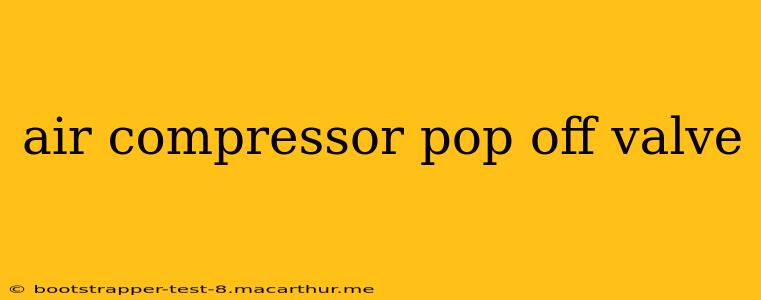An air compressor pop-off valve, also known as a pressure relief valve or safety valve, is a crucial safety feature that prevents the tank from exceeding its maximum pressure rating. This vital component protects both the compressor and, more importantly, the user from potentially dangerous pressure build-up. Understanding how it works, troubleshooting common issues, and knowing when to replace it are essential for safe and efficient air compressor operation.
What is an Air Compressor Pop-Off Valve and How Does it Work?
The pop-off valve is a spring-loaded mechanism designed to release compressed air when the tank pressure reaches a pre-determined limit. This limit is usually stamped on the tank itself and is crucial for safe operation. When the pressure inside the tank surpasses this limit, the spring is overcome by the pressure, and the valve opens, releasing air until the pressure drops back below the threshold. This prevents catastrophic tank failure, which could result in serious injury or property damage. The valve typically makes a distinct "pop" or hissing sound when it releases air, hence the name "pop-off valve."
Why is the Pop-Off Valve Important?
The pop-off valve is paramount for safety reasons. Without it, the pressure inside the tank could continue to rise until the tank ruptures. This rupture could result in:
- Serious injury: High-pressure air can cause severe damage to eyes, lungs, and other body parts.
- Property damage: The force of a ruptured tank can cause significant damage to surrounding objects.
- Compressor damage: Over-pressurization can damage internal compressor components.
Why is My Pop-Off Valve Leaking?
A leaking pop-off valve can indicate several problems:
- Dirty or damaged valve: Dirt, debris, or damage to the valve's internal components can prevent it from sealing properly. This often leads to a slow, continuous leak.
- Worn-out spring: The spring may be worn or weakened, failing to maintain sufficient pressure to keep the valve closed. This can manifest as a constant drip or a consistent hiss.
- Incorrect adjustment: In some cases, the valve might be incorrectly adjusted, allowing for air leakage. This is less common, but possible.
- Excessive pressure: If the pop-off valve is continually activating, it could point to a problem with the compressor's pressure switch or a more significant issue that's causing it to over-pressurize.
How Do I Test My Air Compressor Pop-Off Valve?
Testing your pop-off valve should be done cautiously, and ideally with the compressor unplugged. You want to observe its function, not intentionally trigger a dangerous pressure build up. Here's a method to check for leaks:
- Inspect Visually: Check for any visible damage, debris, or corrosion around the valve.
- Listen Carefully: Listen for any hissing or leaking sounds while the compressor is off. A slight hiss might indicate a slow leak.
- Pressure Gauge Check: Observe the pressure gauge. If it shows a steady pressure drop over a period of time when the compressor isn’t running, it likely points to a leak. Note that even a minor leak over a long time can indicate a serious issue.
Note: Do not attempt to forcefully open or tamper with the pop-off valve. If you suspect a problem, it's best to consult a professional or replace the valve.
How Often Should I Replace My Pop-Off Valve?
The lifespan of a pop-off valve varies depending on usage and environmental conditions. However, regular inspection is key. Consider replacement if you notice any leaks, damage, or if the compressor is showing signs of consistent over-pressurization. It's generally safer to err on the side of caution and replace the valve if you have any doubts about its functionality.
What Happens if My Pop-Off Valve Fails?
A failed pop-off valve can lead to a dangerous over-pressurization of the air tank. This can result in the tank rupturing, causing serious injury or property damage. If your pop-off valve fails, immediately stop using the compressor and have it inspected by a qualified technician.
This information is for educational purposes only. Always consult the manufacturer's instructions for your specific air compressor model and safety procedures. Improper handling of compressed air equipment can be dangerous.
